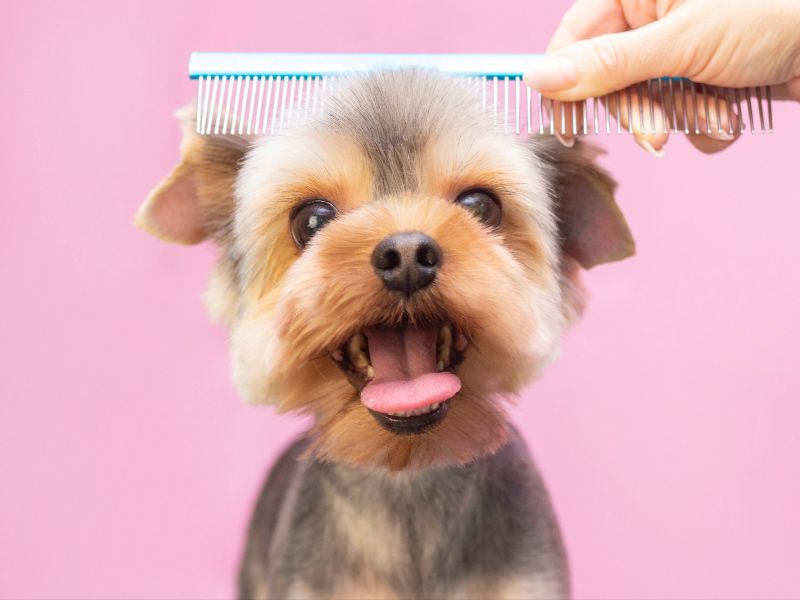Are you a proud fur-parent to a brand-new puppy? Congratulations! As you embark on this exciting journey of pet parenthood, you may be wondering when it’s the right time to schedule your puppy’s first grooming session. Grooming plays a crucial role in maintaining your furry friend’s hygiene and overall well-being, but it’s important to ensure that you don’t rush into it. The age at which a puppy can have its first groom varies depending on several factors, such as breed, coat type, and individual development. In this article, we will explore the ideal age to introduce your puppy to the grooming salon, as well as provide essential tips to make the experience positive and stress-free for your little bundle of joy. So, grab your notepad and get ready to learn everything you need to know about when your puppy can have its first groom!
Importance Of Grooming for Puppies
Grooming is an essential part of caring for your puppy’s physical and mental well-being. Regular grooming helps maintain their coat’s health, prevents matting and tangling, and keeps their skin clean and free from irritations. Additionally, grooming sessions provide an opportunity for you to bond with your puppy and establish trust. By introducing grooming early on, you are setting the foundation for a lifetime of positive experiences and cooperation.
Proper grooming also involves maintaining your puppy’s dental hygiene, which is crucial for their overall health. Regular brushing of their teeth helps prevent dental diseases and keeps their breath fresh. Additionally, grooming sessions allow you to check for any abnormalities or health issues, such as skin infections, parasites, or lumps, which can be addressed early on.
Caring for your puppy’s ears and nails is also an important part of grooming. Regularly cleaning their ears helps prevent ear infections, while trimming their nails ensures they are at a comfortable length and prevents discomfort or injury. Overall, grooming is a holistic approach to keeping your puppy healthy, happy, and looking their best.
When To Start Grooming a Puppy
The ideal age to start grooming your puppy can vary depending on several factors. Breed, coat type, and individual development all play a role in determining when your puppy is ready for their first grooming session. However, as a general guideline, puppies can typically have their first groom around 8-12 weeks of age. By this time, they have usually settled into their new home and are more receptive to new experiences.
It’s important to note that while grooming can start around this age, it’s crucial to introduce the process gradually and make it a positive experience for your puppy. This will help them associate grooming with something enjoyable rather than something to be feared or stressed about. Additionally, starting grooming early allows your puppy to become accustomed to being handled, which will make future grooming sessions much easier.
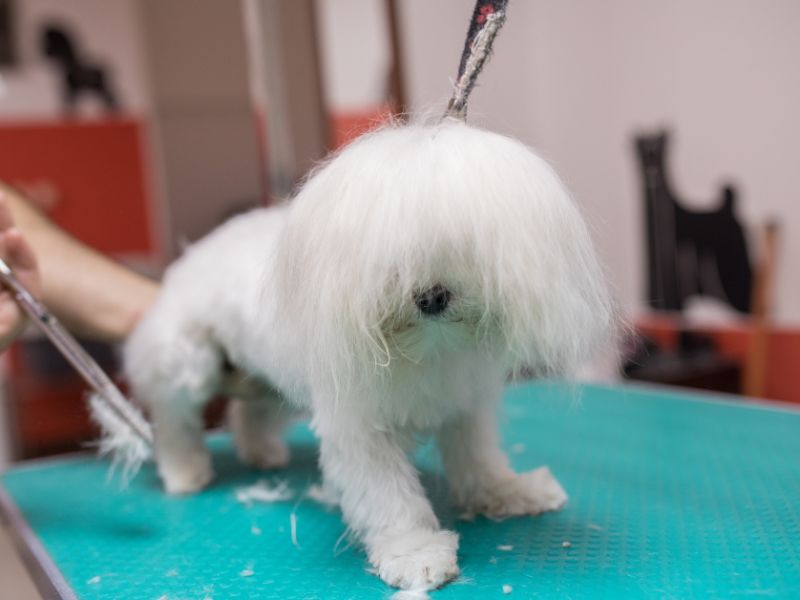
Preparing Your Puppy for Its First Grooming Session
Before taking your puppy to the grooming salon for the first time, it’s important to prepare them for the experience to ensure a positive and stress-free visit. Here are a few essential tips to help you prepare your puppy for their first grooming session:
- Socialize your puppy: Exposing your puppy to different people, animals, and environments from an early age helps them become more confident and adaptable. This will make the grooming experience less intimidating for them.
- Get them used to being handled: Regularly handle your puppy’s paws, ears, and mouth to get them comfortable with being touched in these sensitive areas. This will make it easier for the groomer to handle them during the grooming process.
- Introduce grooming tools: Gradually introduce your puppy to grooming tools such as brushes, combs, and nail clippers. Start by letting them sniff and investigate the tools before gradually incorporating them into their grooming routine.
- Positive reinforcement: Reward your puppy with treats, praise, and affection during grooming sessions or whenever they display good behavior. This will associate grooming with positive experiences and make them more cooperative during future sessions.
By following these tips, you can help your puppy feel more relaxed and confident during their first grooming session.
Finding A Reputable Groomer for Your Puppy
When it comes to choosing a groomer for your puppy, it’s important to do your research and find a reputable and experienced professional. Here are a few steps to consider when selecting a groomer:
- Ask for recommendations: Seek recommendations from friends, family, or your veterinarian. Personal experiences and referrals can provide valuable insights into the quality of service a groomer provides.
- Visit the grooming salon: Take a tour of the grooming salon before booking an appointment. Look for cleanliness, proper equipment, and a calm and safe environment. A well-maintained salon reflects the groomer’s professionalism and commitment to the well-being of the animals in their care.
- Check qualifications and certifications: Inquire about the groomer’s qualifications, certifications, and training. A professional groomer should have the necessary knowledge and skills to handle different breeds and coat types.
- Communication and rapport: Ensure that the groomer communicates effectively and listens to your concerns and preferences. A good groomer should be able to understand your puppy’s individual needs and tailor the grooming session accordingly.
Taking the time to find a reputable groomer will give you peace of mind knowing that your puppy is in capable hands.
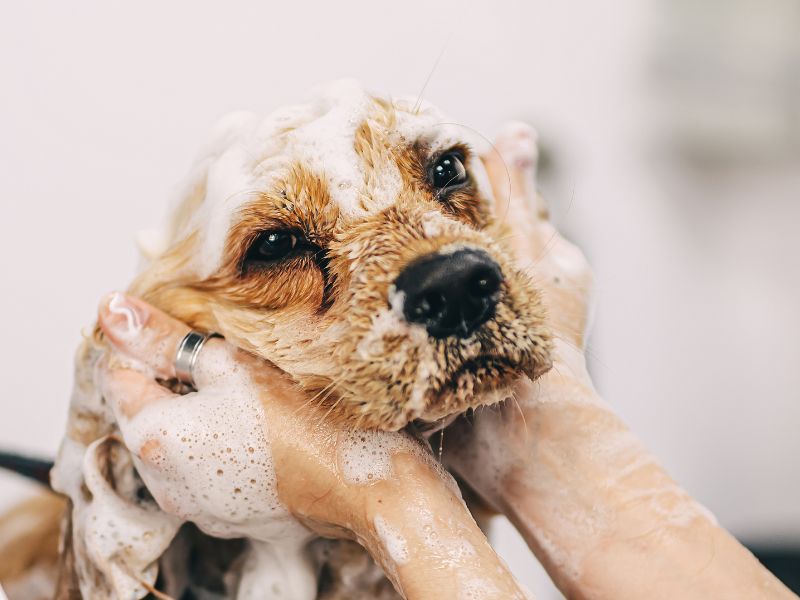
What To Expect During Your Puppy’s First Grooming Session
During your puppy’s first grooming session, several procedures may be carried out depending on their age, breed, and specific needs. Here’s what you can expect during your puppy’s first grooming session:
- Introduction and assessment: The groomer will start by introducing themselves to your puppy and assessing their coat condition, skin health, and overall grooming needs. This initial assessment helps the groomer determine the most appropriate grooming techniques and products to use.
- Brushing and combing: Brushing and combing are essential grooming steps to remove any loose hair, prevent matting, and promote a healthy coat. The groomer will use appropriate tools based on your puppy’s coat type.
- Bathing and drying: If necessary, your puppy will be given a bath using a gentle, puppy-safe shampoo. The groomer will ensure that the water temperature is comfortable and will use a technique that minimizes stress. After the bath, your puppy will be dried using a towel or a low-heat dryer.
- Nail trimming: Trimming your puppy’s nails is important for their comfort and mobility. The groomer will carefully trim the nails, ensuring they are not cut too short to avoid causing bleeding or pain.
- Ear cleaning: The groomer will clean your puppy’s ears using a gentle cleanser and cotton balls. This helps prevent ear infections and keeps their ears clean and healthy.
- Styling and finishing touches: Depending on your preferences and your puppy’s breed, the groomer may style their coat, trim their fur, or give them a cute bow or bandana to complete the grooming session.
Throughout the grooming process, the groomer will ensure your puppy’s safety and comfort, taking breaks if needed and providing reassurance. It’s important to remember that each puppy’s first grooming experience may vary, and some puppies may require multiple sessions to become fully comfortable with the process.
Common Grooming Services for Puppies
During your puppy’s grooming session, there are several common services that may be offered depending on their breed and individual needs. These services can include:
- Brushing and combing: Regular brushing and combing help prevent matting, remove loose hair, and maintain a healthy coat.
- Bathing: Puppies may receive a bath using gentle, puppy-specific shampoos to keep their coat clean and fresh.
- Nail trimming: Trimming your puppy’s nails ensures they are at a comfortable length and prevents discomfort or injury.
- Ear cleaning: Cleaning your puppy’s ears helps prevent ear infections and keeps their ears healthy.
- Teeth brushing: Regular brushing of your puppy’s teeth helps maintain their dental hygiene and prevents dental diseases.
- Gland expression: Some puppies require their anal glands to be expressed to prevent discomfort or infection. This is typically done by the groomer during the grooming session.
It’s important to discuss your puppy’s specific grooming needs with the groomer to ensure they receive the appropriate services.
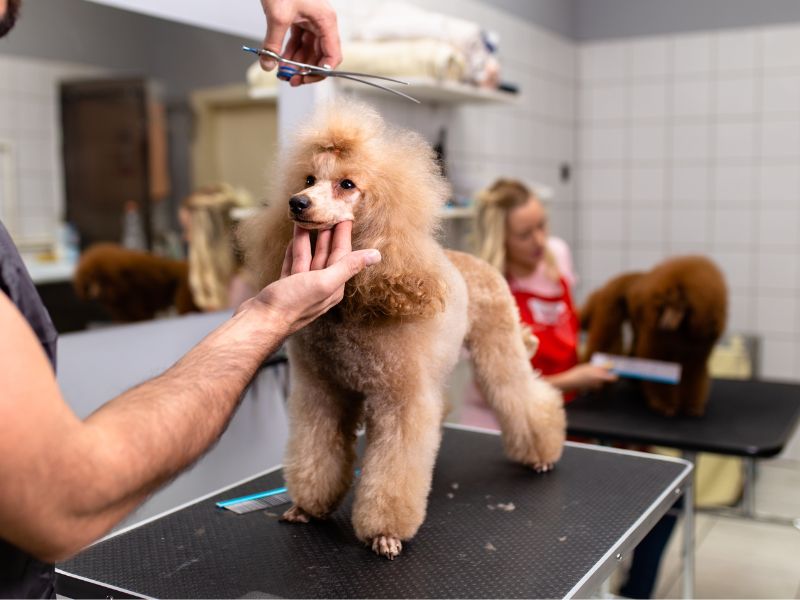
See Also: How to Keep Your Dog Calm During Fireworks Season
And: All You Need to Know About the Affenpinscher
Tips For Maintaining Your Puppy’s Grooming Routine at Home
While regular visits to the groomer are important, maintaining your puppy’s grooming routine at home is equally essential. Here are a few tips to help you maintain your puppy’s grooming routine between salon visits:
- Regular brushing: Brush your puppy’s coat regularly, especially if they have longer hair or a double coat. This helps prevent matting, removes loose hair, and keeps their coat healthy.
- Dental care: Brush your puppy’s teeth regularly using a dog-specific toothbrush and toothpaste. This helps prevent dental diseases and keeps their breath fresh.
- Nail trimming: Trim your puppy’s nails regularly to ensure they are at a comfortable length. Use pet-specific nail clippers and be careful not to cut too close to the quick, which can cause bleeding.
- Ear cleaning: Clean your puppy’s ears regularly using a gentle cleanser and cotton balls. This helps prevent ear infections and keeps their ears clean.
- Eye care: Check your puppy’s eyes regularly for any discharge or redness. Use a damp cotton ball to gently clean around their eyes if needed.
- Regular check-ups: Schedule regular veterinary check-ups to ensure your puppy’s overall health and catch any potential issues early.
By incorporating these practices into your puppy’s daily routine, you can help maintain their grooming needs in between professional grooming sessions.
Potential Challenges During Puppy Grooming
Grooming a puppy can sometimes present challenges, especially during their first few sessions. It’s important to be aware of these potential challenges and address them appropriately to ensure a positive grooming experience for your puppy. Some common challenges include:
- Fear or anxiety: Some puppies may experience fear or anxiety during grooming, especially if they are not accustomed to being handled or have had a negative experience in the past. Gradual desensitization, positive reinforcement, and patience can help alleviate these fears over time.
- Restlessness or hyperactivity: Puppies are known for their boundless energy, which can make it difficult for them to stay still during grooming. Shorter, more frequent grooming sessions may be necessary to accommodate their attention span.
- Sensitivity to grooming tools: Some puppies may be sensitive to the sound or sensation of grooming tools such as clippers or dryers. Introduce these tools gradually and ensure that they are used in a gentle and non-threatening manner.
- Matting or tangles: Puppies with long or curly hair are prone to matting and tangling, which can be challenging to handle during grooming. Regular brushing and using appropriate grooming tools can help prevent matting and make the grooming process easier.
- Resistance to nail trimming: Trimming a puppy’s nails can be challenging if they are resistant or fearful. Positive reinforcement and gradual desensitization can help them become more comfortable with the process over time.
By addressing these challenges with patience, positive reinforcement, and gradually introducing your puppy to the grooming process, you can help them overcome any potential issues and make grooming a positive experience.
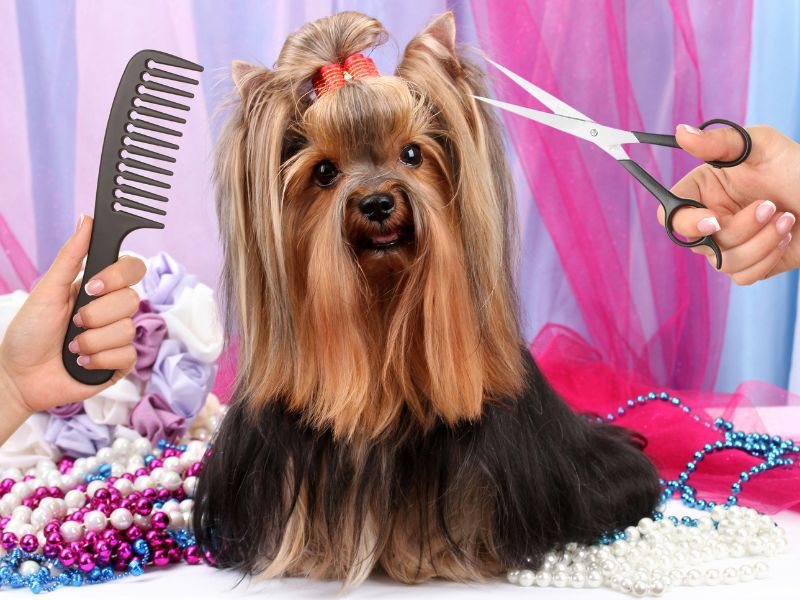
How Often Should a Puppy Be Groomed?
The frequency of grooming sessions for your puppy depends on several factors, including their breed, coat type, and individual needs. As a general guideline, most puppies benefit from grooming every 4-6 weeks. However, some breeds with specific grooming requirements may require more frequent sessions, while others with low-maintenance coats may require less frequent grooming.
Regular brushing at home should be done at least once a week to prevent matting and maintain a healthy coat. Additionally, maintaining your puppy’s dental hygiene, trimming their nails, and cleaning their ears should be done on a regular basis.
It’s important to consult with your groomer and veterinarian to determine the most suitable grooming schedule for your puppy based on their specific needs.
Conclusion
Introducing your puppy to grooming at the right age is essential for their well-being and overall health. By following the guidelines and tips in this article, you can ensure that your puppy’s first grooming experience is positive and stress-free. Remember to start grooming gradually, prepare your puppy for the experience, and find a reputable groomer who understands your puppy’s individual needs. Regular grooming sessions and at-home maintenance will help keep your puppy’s coat healthy, their teeth clean, and their overall grooming routine a pleasant and bonding experience for both of you. Enjoy this exciting journey of pet parenthood and revel in the joy of having a well-groomed and happy puppy by your side!

